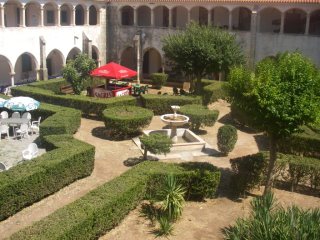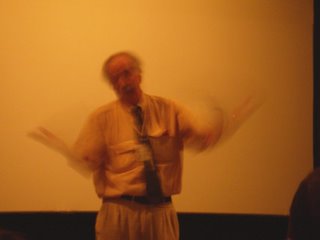VII congresso nacional
Last week was the national geology conference in Estremoz, held in the town theatre and the old convent and run by the government and the universities. For those who are not geologists/academics looking at this photo imagining afternoon beers in the garden and lunch/dinner under the cloisters instead of learning are all you need before you read the next post or the next blog :)  The programme was made up mostly of research in Portuguese geology - structural geology, stratigraphy, tectonic evolution, geochemistry (dating, isotopic data), fossils/sedimentology. A half day of "Resources Geology" included 90% of the talks on mineralisation, uniquely these included talks on ornamental stone (marble) and economic clay/feldspar deposits. More time was spent on environmental geology and "surface processes". Understandable given that this was a scientific conference not a industry or resources-focused conference, but economic geology still makes up a large part of scientific conferences in Australia, especially the national ones. Also these conferences attract more national/international scientists so talks will cover a variety of locations if not different branches of the science. But Portugal is not a large country, and therefore this was similar to some of the smaller state geology conferences.
The programme was made up mostly of research in Portuguese geology - structural geology, stratigraphy, tectonic evolution, geochemistry (dating, isotopic data), fossils/sedimentology. A half day of "Resources Geology" included 90% of the talks on mineralisation, uniquely these included talks on ornamental stone (marble) and economic clay/feldspar deposits. More time was spent on environmental geology and "surface processes". Understandable given that this was a scientific conference not a industry or resources-focused conference, but economic geology still makes up a large part of scientific conferences in Australia, especially the national ones. Also these conferences attract more national/international scientists so talks will cover a variety of locations if not different branches of the science. But Portugal is not a large country, and therefore this was similar to some of the smaller state geology conferences.
Having been in industry for a while "academic" geology is a little frustrating, Differences in opinion in geology are normal as its an interpretative science, but because academia involves researching in schools new data is often taken to prove or disprove that groups theories instead of leading to new conclusions. Such proof is essential not only in the dash for government grants but also in continuing age-old academic battles about where to draw the line in the sand (literally in geology!). In industry we have the advantage that interpretation is essential but we don't have to prove or disprove our own, if it turns out not to work then we try another way. Often we can test two or three different interpretations in one work programme, and because our aim is a resource then the assays, the numbers are hard proof of what's right or wrong. So going back to watching arguments about how old this formation is or when this tectonic event ended or sitting through Powerpoint slide after (not viewer friendly) slide of geochemical/isotope data without any apparently conclusions makes you want to scream. Or bunk off and have a beer in the square!  It can also go over a simple rig geo's head talking about supercontinents, Wilson cycles and thermal gradients. But the big picture, the talk of how our world developed, evolved and is changing today can spark you too. I got to hear Antonio Ribeiro, the inspiration for much of Portugal's geologists/research today, photographed above as he transformed from stooping, grey mustached elderly man into an arm-waving prophet, animated by the force of his ideas. It was the presentation you expect from an elder statesman, a million OHPs whipped off the projector almost as fast as they were placed there, usually upside down/the wrong way round, faded photos of different outcrops/cliffs, hand-drawn diagrams, images photocopied from different papers and even magazines.
It can also go over a simple rig geo's head talking about supercontinents, Wilson cycles and thermal gradients. But the big picture, the talk of how our world developed, evolved and is changing today can spark you too. I got to hear Antonio Ribeiro, the inspiration for much of Portugal's geologists/research today, photographed above as he transformed from stooping, grey mustached elderly man into an arm-waving prophet, animated by the force of his ideas. It was the presentation you expect from an elder statesman, a million OHPs whipped off the projector almost as fast as they were placed there, usually upside down/the wrong way round, faded photos of different outcrops/cliffs, hand-drawn diagrams, images photocopied from different papers and even magazines.

1 comment:
Oooh, this entry filled me with morbid academic fascination! Thank you.
Post a Comment